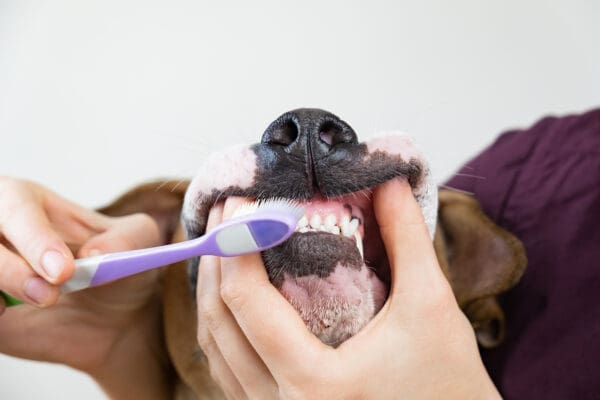
Choosing a new pet food to feed can be a challenge in today’s market. There are hundreds of options available from local grocery stores, pet stores, veterinarians and online retailers. With all of the colorful labels, claims and incentives advertised, navigating your way through the pet food isle can be confusing. So here at the Veterinary Medical Center-Michigan State University, we’ve provided the following information to help you select a food that is well suited to a healthy dog or cat, regardless of its life stage.
Choose A Company
Initially, your search for a new pet food should start with a brand of food from a company that you’re familiar with or trust. Brands of food are usually chosen based on owner preferences, such as previous experience or cost or claims like “natural” or “holistic”. Some pet owners choose foods based on the list of ingredients or pictures on the label. Whatever you’re reasoning for a particular brand, you should spend time investigating the company that manufactures the product.
Reputation and excellent customer service should factor into your food choice. When you call a company to ask questions, are you left on hold for long periods of time? Are you treated in a respectful manner? Companies that are helpful and provide the information you ask for in a timely manner are those you want to deal with. Not only are they more likely to listen if you have a problem with their product, but they are more likely to be up front about dealing with issues and correcting their mistakes. The FDA currently hosts a website where pet food manufacturers can voluntarily recall a product that they believe may be unsafe. Ideally, the company you choose should be one you feel would put the health of your pet first.
Look For The AAFCO Feeding
Claim
At the same time you are evaluating companies and brands, you should be looking for the nutritional claim on the label. This is called the “AAFCO Nutritional Adequacy Statement”. AAFCO stands for the Association of American Feed Control Officials; this organization establishes and publishes nutritional standards for pet foods. When looking for the AAFCO claim on a pet food label, you may see one of the following statements:
“(Product Name) is formulated to meet the nutritional levels established by the AAF- CO Dog/Cat nutrient profiles for (specific life stage such as growth or adult maintenance)”.
Or “Animal feeding tests using AAFCO procedures substantiate that (name of product) provides complete and balanced nutrition for (specific life stage)”.
The difference between these two statements is an actual feeding trial. In the first claim, the manufacturer has developed a diet using the AAFCO nutrient guidelines and has completed a nutritional analysis to ensure minimum requirements were met. With this type of claim, a food does not go through animal feeding tests prior to being sold. Alternatively, the second statement indicates that the diet has not only been formulated to meet minimum nutrient requirements, but has also been fed to dogs or cats to ensure the product is safe and animals maintain good health and body weight while eating the food.
You can also use the AAFCO nutritional adequacy statement to confirm that a food is appropriate for the life stage of your dog or cat. AAFCO establishes minimal nutrient requirements for these life stages: growth and reproduction, and adult maintenance. It is also possible that a pet food label will state that a product is appropriate for “all life stages”, which means that the food meets minimum requirements for adult maintenance, growth and reproduction.
Consider Cost
The cost of pet food is worthy of your time and attention. The range of what we might pay for dog or cat food varies from as little as $5.00 per bag to more than $100.00
per bag. However, the price of the can or bag doesn’t tell us anything about the quality of what’s inside. Choose a food that first meets the nutritional requirements discussed above, and one that falls within your budget for your pet. Do not assume a more expensive bag of food is necessarily better for your pet.
Watch Your Animal
Probably the most important criteria for selecting a new food is how your pet responds. While you may think you’ve found the perfect food, the real test is whether or not your dog or cat will eat it and do well on it. Observe your pet’s appetite before and after changing diets to compare behavior, appetite, changes in body weight, and/or changes in peeing or pooping habits. Does your pet readily eat the new food? Do they seek out other food sources even after eating? Are they maintaining a good body weight? Do they have bouts of vomiting, diarrhea or excessive gas? These are all indicators of whether your pet should continue to eat a new food you’re trying to introduce or if you should go back to what was working before.
Summary
Choosing a pet food can be a difficult decision with so many options available in the marketplace. Remember to find a reputable company, check the AAFCO Nutritional Adequacy Statement and find a brand that suits your pet’s life stage needs to help narrow your search. An in- dividual feeding trial with close monitoring is going to be an important factor in your selection process too. When you have questions or concerns about your pet’s diet, don’t hesitate to consult your veterinarian for information and guidance.
Reposted from Veterinary Medical Center -College of Veterinary Medicine Michigan State University.



